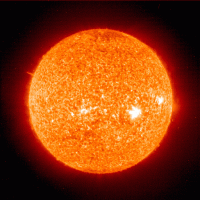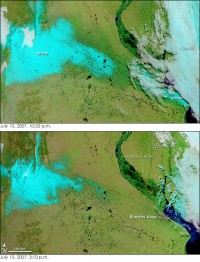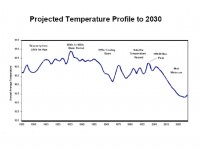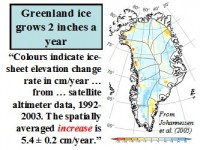Jul 16, 2007
The Truth Is, We Can’t Ignore the Sun
By David Whitehouse
According to the headlines last week, the sun is not to blame for recent global warming: mankind and fossil fuels are. So Al Gore is correct when he said, “the scientific data is in. There is no more debate.” Of that the evangelical BBC had no doubt. There was an air of triumphalism in its coverage of the report by the Royal Society.

But there is a deeper and more worrying issue. Last week’s research is a simple piece of science and fundamentally flawed. Nobody looked beyond the hype; if they had, they would have reached a different conclusion. The report argues that while the sun had a significant effect on climate during most of the 20th century, its influence is currently dwarfed by human effects. It says that all known solar influences since about 1990 are downward and because global temperature has increased since then, the sun is not responsible.
No. The research could prove the contrary. Using the global temperature data endorsed by the Inter-national Panel on Climate Change, one can reach a completely different conclusion. Looking at annual global temperatures, it is apparent that the last decade shows no warming trend and recent successive annual global temperatures are well within each year’s measurement errors. Statistically the world’s temperature is flat. The world certainly warmed between 1975 and 1998, but in the past 10 years it has not been increasing at the rate it did.
My own view on the theory that greenhouse gases are driving climate change is that it is a good working hypothesis - but, because I have studied the sun, I am not completely convinced. The sun is by far the single most powerful driving force on our climate, and the fact is we do not understand how it affects us as much as some think we do. So look on the BBC and Al Gore with scepticism. A scientist’s first allegiance should not be to computer models or political spin but to the data: that shows the science is not settled. See full story here.
Jul 12, 2007
NASA Photos of the Argentina Snowfall
NASA GSFC
For the first time since 1918, snow fell in Buenos Aires, Argentina, late on July 9, 2007, reported the Associated Press. The snow was still there the next morning when the Moderate Resolution Imaging Spectroradiometer (MODIS) flew over on NASA’s Terra satellite at 10:55 a.m. local time. This false-color image, made with a combination of infrared and visible light, reveals the snow beneath the clouds that still hang over the coast. In this image, snow is pale turquoise blue, while clouds are lighter blue and white. Not only does the snow blanket Buenos Aires, but it also covers a broad section of the highlands to the west.

The snow was short-lived, however. By the time MODIS flew over on the Aqua satellite at 3:10 p.m. local time, both snow and clouds were gone from Buenos Aires, the cement-colored area on the southern bank of the Rio de la Plata in the lower image. The snow had also receded significantly in the higher elevations. The snow fell during a long cold snap that claimed 23 lives and caused an energy crisis, said the Associated Press.
True-color, photo-like images of the snow in Argentina are available from the MODIS Rapid Response System. NASA images courtesy the MODIS Rapid Response Team at NASA GSFC. See Argentina Snowfall from Satellite
Jul 07, 2007
The Past and Future of Climate
By David Archibald
In this paper, I will put forward a prediction of climate to 2030 that differs from most in the public domain. It is a prediction of imminent cooling. I will examine the role of the Sun in changing climate and, following that, the contribution of anthropogenic warming from carbon dioxide. I will finish up combining a solar-driven prediction and the anthropogenic contribution to make a prediction of climate to 2030.
According to Schatten and Tobiska at the 34th Solar Physics Division Meeting of the American Astronomical Societyin 2003 “The surprising result of these long-range predictions is a rapid decline in solar activity, starting with cycle #24. If this trend continues, we may see the Sun heading towards a “Maunder” type of solar activity minimum - an extensive period of reduced levels of solar activity.” Ken Schatten is the solar physicist with the best track record in predicting solar cycles. His work suggests a return to the advancing glaciers and delayed spring snow melt of the Little Ice Age, for an indeterminate period.

There are no deleterious consequences of higher atmospheric carbon dioxide levels. Higher atmospheric carbon dioxide levels are wholly beneficial. Anthropogenic Global Warming is so minuscule that the effect cannot be measured from year to year, and even from generation to generation. Our generation has bathed in the warm glow of a benign, giving Sun, but the next will suffer a Sun that is less giving, and the Earth will be less fruitful.
Jul 05, 2007
Fossil DNA Proves Greenland Once Had Lush Forests; Ice Sheet Is Surprisingly Stable
Science Daily
Ancient Greenland was green. New Danish research has shown that it was covered in conifer forest and, like southern Sweden today, had a relatively mild climate. Eske Willerslev, a professor at Copenhagen University, has analysed the world’s oldest DNA, preserved under the kilometre-thick icecap. The DNA is likely close to half a million years old, and the research is painting a picture which is overturning all previous assumptions about biological life and the climate in Greenland.
The research results are the first direct proof that there was forest in southern Greenland. Furthermore Willerslev found genetic traces of insects such as butterflies, moths, flies and beetles. But when was that? According to most scientific theories to date, all of southern Greenland and most of the northern part were ice-free during the last interglacial period 125,000 years ago, when the climate was 5 degrees warmer than the interglacial period we currently live in.
 Credit: Drawing of reconstruction of ancient Greenland by Bent Jærdig Knudsen Credit: Drawing of reconstruction of ancient Greenland by Bent Jærdig Knudsen
This theory however, was not confirmed by Willerslev and co-workers subsequent datings. He analysed the insects’ mitochondria, which are special genomes that change with time and like a clock can be used to date the DNA. He also analysed their amino acids which also change over time. Both datings showed that the insects were at least 450,000 years old. That signifies that there was ice there during the Eemian interglacial period 125,000 years ago. It means that although we are now confronted with global warming, the whole ice sheet will not melt and bring about the tremendous sea-level rises which have been the subject of so much discussion.
The results have just been published in the journal Science. See full story here.
Jul 01, 2007
Dynamics of Greenhouse Effect
By Lubos Motl, The Reference Frame
The Gentlemen at RealClimate.ORG have decided that my article about climate sensitivity and similar articles by others are too dangerous because they show that every new molecule of CO2 causes smaller greenhouse effect than the previous molecule: the absorption rate gradually approaches saturation. Such a conclusion could diminish the holy power of the enhanced greenhouse effect and undermine the global efforts of scientists of good faith - and their friends, politicians of good faith, lawyers of good faith, singers of good faith, and publishers of good faith - to globally regulate the greenhouse effect.
They must be applauded for giving others the opportunity to study and discuss this question more carefully because the more people know, the more they will see why the hysteria is unjustifiable. So what do these eleven climate scientists think about the dependence of the strength of the greenhouse effect on the concentration? Well, they live in the state of scientific consensus which means, in this case, that none of them has any idea what the answer could be. So they invited an expert to clarify the situation.
Who is the expert? Well, it is a noted historian of science whose name is Spencer Weart, a guest blogger at Real Climate.
Ray Pierrehumbert has helped Weart to reduce excessive hyphenation. Weart is the author of a painful book that celebrates a greedy group of researchers who were dreaming about grants and who finally got them after they constructed the man-made global warming theory. Weart writes in such a way that the text is well-readable and looks insightful to superficial readers. If you read it carefully, however, you can see that Weart has no idea what he is talking about at the technical level.
Spencer Weart’s main goal is to deny or somewhat diminish the importance of the following two observations: (1) the greenhouse effect gets weaker as the absorption of the appropriate spectral lines gets saturated and (2) the overall greenhouse effect from several gases is smaller than a simple sum if their spectra overlap. See full Motl blog here.
|






 Credit: Drawing of reconstruction of ancient Greenland by Bent Jærdig Knudsen
Credit: Drawing of reconstruction of ancient Greenland by Bent Jærdig Knudsen